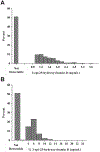Investigation of the C-3-epi-25(OH)D3 of 25-hydroxyvitamin D3 in urban schoolchildren
- PMID: 29053944
- PMCID: PMC6563605
- DOI: 10.1139/apnm-2017-0334
Investigation of the C-3-epi-25(OH)D3 of 25-hydroxyvitamin D3 in urban schoolchildren
Abstract
The physiological relevance C-3 epimer of 25-hydroxyvitamin D (3-epi-25(OH)D) is not well understood among youth. The objective of this study was to assess whether demographic/physiologic characteristics were associated with 3-epi-25(OH)D3 concentrations in youth. Associations between 3-epi-25(OH)D3 and demographics and between 3-epi-25(OH)D3, total 25-hydroxyvitamin (25(OH)D) (25(OH)D2 + 25(OH)D3), total cholesterol, high-density lipoprotein, low-density lipoprotein, and triglycerides were examined in racially/ethnically diverse schoolchildren (n = 682; age, 8-15 years) at Boston-area urban schools. Approximately 50% of participants had detectable 3-epi-25(OH)D3 (range 0.95-3.95 ng/mL). The percentage of 3-epi-25(OH)D3 of total 25(OH)D ranged from 2.5% to 17.0% (median 5.5%). Males were 38% more likely than females to have detectable 3-epi-25(OH)D3 concentrations. Both Asian and black race/ethnicity were associated with lower odds of having detectable 3-epi-25(OH)D3 compared with non-Hispanic white children (Asian vs. white, odds ratio (OR) 0.28, 95% confidence interval (CI) 0.14-0.53; black vs. white, OR 0.38, 95%CI 0.23-0.63, p < 0.001). Having an adequate (20-29 ng/mL) or optimal (>30 ng/mL) 25(OH)D concentration was associated with higher odds of having detectable 3-epi-25(OH)D3 than having an inadequate (<20 ng/mL) concentration (OR 4.78, 95%CI 3.23-6.94 or OR 14.10, 95%CI 7.10-28.0, respectively). There was no association between 3-epi-25(OH)D3 and blood lipids. However, when considering 3-epi-25(OH)D3 as a percentage of total 25(OH)D, total cholesterol was lower in children with percent 3-epi-25(OH)D3 above the median (mean difference -7.1 mg/dL, p = 0.01). In conclusion, among schoolchildren, sex, race/ethnicity, and total serum 25(OH)D concentration is differentially associated with 3-epi-25(OH)D. The physiological relevance of 3-epi-25(OH)D3 may be related to the 3-epi-25(OH)D3 as a percentage of total 25(OH)D and should be considered in future investigations.
La pertinence physiologique de l’épimère C-3 de la 25-hydroxyvitamine D (« 3-epi-25(OH)D ») chez les jeunes n’est pas bien établie. Cette étude se propose de vérifier si des caractéristiques démographiques/physiologiques sont associéesà la concentration de 3-epi-25(OH)D chez les jeunes. On examine, chez des enfants d’âge scolaire de diverses races/ethnies (n = 682, âge : 8–15 ans) dans la région urbaine de Boston, la relation entre 3-epi-25(OH)D3 et des variables démographiques, entre 3-epi-25(OH)D3 et 25-hydroxyvitamine (« 25(OH)D ») (25(OH)D2 + 25(OH)D3) totale, cholestérol total, lipoprotéines de haute densité, lipoprotéine de faible densité et les triglycérides. Environ 50 % des enfants présentent une concentration détectable de 3-epi-25(OH)D3 (écart : 0,95−3,95 ng/mL). Le pourcentage de 3-epi-25(OH)D3 parrapportà25(OH)Dtotalevariede2,5à17,0%(médiane:5,5%). Lesgarçonssont38%plusà mêmequelesfillesdeprésenterune concentration détectable de 3-epi-25(OH)D3. Les enfants de race/ethnie noire et asiatique ont une plus faible probabilité de présenter une concentration détectable de 3-epi-25(OH)D3 comparativement aux enfants de race blanche non hispaniques (Asiatiques vs Blancs, rapport des cotes (RC) 0,28, intervalle de confiance (IC) 95 % 0,14–0,53; Noirs vs Blancs, RC 0,38, IC 95 % 0,23−0,63, p < 0,001). Un taux adéquat (20–29 ng/mL) ou optimal (>30 ng/mL) de 25(OH)D est associéà une probabilité plus élevée de présenter une concentration détectable de 3-epi-25(OH)D3 comparativementà un taux inadéquat (<20 ng/mL) : RC 4,78, IC 95 % 3,23–6,94 ou RC 14,10, IC 95 % 7,10–28,0, respectivement. Il n’y a pas de relation entre 3-epi-25(OH)D3 et les lipides sanguins. Toutefois, en considérant 3-epi-25(OH)D3 en pourcentage de 25(OH)D totale, les enfants présentant un taux de 3-epi-25(OH)D3 supérieurà la médiane (différence moyenne :−7,1 mg/dL, p = 0,01) ont un plus faible taux de cholestérol total. Conclusion. Chez les enfants d’âge scolaire, le sexe, la race/ethnie et la concentration sérique de 25(OH)D totale sont différemment associés au taux de 3-epi-25(OH)D. La pertinence physiologique de 3-epi-25(OH)D3 pourrait être envisagée en pourcentage de 25(OH)D totale et devrait être prise en considération dans les études ultérieures. [Traduit par la Rédaction]
Keywords: 25-hydroxyvitamin D3; 25-hydroxyvitamine D3; C-3 epimer; Daily D Health Study; vitamin D; vitamine D; épimère C-3; étude de la vitamine D journalière sur la santé.
Figures


References
-
- Aghajafari F, Field CJ, Rabi D, Kaplan BJ, Maggiore JA, O’Beirne M, et al. 2016. Plasma 3-epi-25-hydroxycholecalciferol can alter the assessment of vitamin D status using the current reference ranges for pregnant women and their newborns. J. Nutr 146(1): 70–75. doi:10.3945/jn.115.220095. - DOI - PubMed
-
- Bao W, Srinivasan SR, Valdez R, Greenlund KJ, Wattigney WA, and Berenson GS 1997. Longitudinal changes in cardiovascular risk from childhood to young adulthood in offspring of parents with coronary artery disease: the Bogalusa Heart Study. JAMA J. Am. Med. Assoc 278(21): 1749–1754. doi:10.1001/jama.1997.03550210047037. - DOI - PubMed
-
- Cashman KD, Kinsella M, Walton J, Flynn A, Hayes A, Lucey AJ, et al. 2014. The 3 epimer of 25-hydroxycholecalciferol is present in the circulation of the majority of adults in a nationally representative sample and has endogenous origins. J. Nutr 144(7): 1050–1057. doi:10.3945/jn.114.192419. - DOI - PMC - PubMed
MeSH terms
Substances
Grants and funding
LinkOut - more resources
Full Text Sources
Other Literature Sources
Miscellaneous

